
Many Kashmir farmers have been deterred from engaging in saffron cultivation as a result of the selling of cheaper and inferior Iranian saffron in the Indian capital market and throughout the world. Iranian saffron is up to 48% cheaper than Kashmiri saffron, and it controls 95% of the global market.
Saffron cultivation is a significant contribution to the Union Territory's agriculture industry, which employs over 80% of the population.
Saffron Cultivation and Major regions
Saffron is grown mostly in three districts: Pulwama, Srinagar, and Budgam, and covers 3,715 hectares. Pampore, a township in Pulwama district, yields the most saffron in the Region, with roughly 3,200 hectares of land underneath cultivation. Saffron is grown on 165 and 300 hectares in Srinagar and Budgam, respectively Kishtwar is the sole district in the Jammu region to grow the spice on 50 hectares.
When the purple harvest arrives in fall, the flowers are plucked, the crimson red stigma is withdrawn, and the stigma is dried for days until it reduces to the size of a slender thread. Saffron stigmas weigh roughly 2 mg each, and each blossom has three stigmata usually.
Because of the increased percentage of crocin, a carotenoid pigment that gives saffron its color and medicinal benefits, Kashmiri saffron is of a better grade. It contains 8.72 percent crocin, contrasted to 6.82 percent in the Iranian variant, giving it a deeper color and more medicinal value.
Because the autumn and winter seasons saw a lot of rain, producers are anticipating a bigger harvest next year.
National Saffron Mission and increase in production
The last time Kashmir produced 15 metric tonnes of saffron annually was in 1996 when the average yield was 2.80 kg per hectare and the farmed area was 5,707 hectares.
Saffron output fell by 35% (10.40MT) till 2010, as the planted area reduced to just 3,715 hectares. The Ministry of Agriculture launched the Rs 400.11 crore National Saffron Mission after realizing that the world's most expensive spice was becoming extinct in Kashmir. While the mission was unable to revive the farmland, the government was successful in expanding saffron production in Kashmir.
GI Tagging and Timely Rainfall
According to the Trade Promotion Council of India, India was the fourth-largest importer of Iranian saffron before 2020, with $18.30 million in saffron imported from Iran. The Iranian variety, which sold for Rs 1 lakh per kg, influenced the price of high-quality Kashmiri saffron, which dropped from Rs 2-3 lakh in 2007 to Rs 1 lakh per kg.
Many Kashmir farmers have been deterred from engaging in saffron cultivation as a result of the invasion of cheap Iranian saffron into Indian and international markets. To conserve high-quality Kashmiri saffron, the Geographical Indication Registry approved GI tagging on the saffron with GI number 635 in 2020. The majority of producers had increased yield last year, because of favorable weather conditions. "Even the borewells created under the National Saffron Mission were not utilized." In August, September, and October, saffron requires rainfall, which the valley received on time.
The majority of producers had increased yield last year, because of favorable weather conditions. "Even the borewells created under the National Saffron Mission were not utilized." In August, September, and October, saffron requires rainfall, which the valley received on time.
The Pandemic Worry
The National Accreditation Board for Testing and Calibration Laboratories (NABL) has granted accreditation to the India International Kashmir Saffron Trading Centre (IIKSTC) in Pampore, providing saffron exports a much-needed boost.
Farmers are especially concerned about lower demand for saffron as a result of the pandemic, despite the increased output. The epidemic, according to the growers, has resulted in losses in the previous two years. According to Abdul Gani, a saffron producer, "there was a lockout and many of our growers didn't get orders for saffron."

















